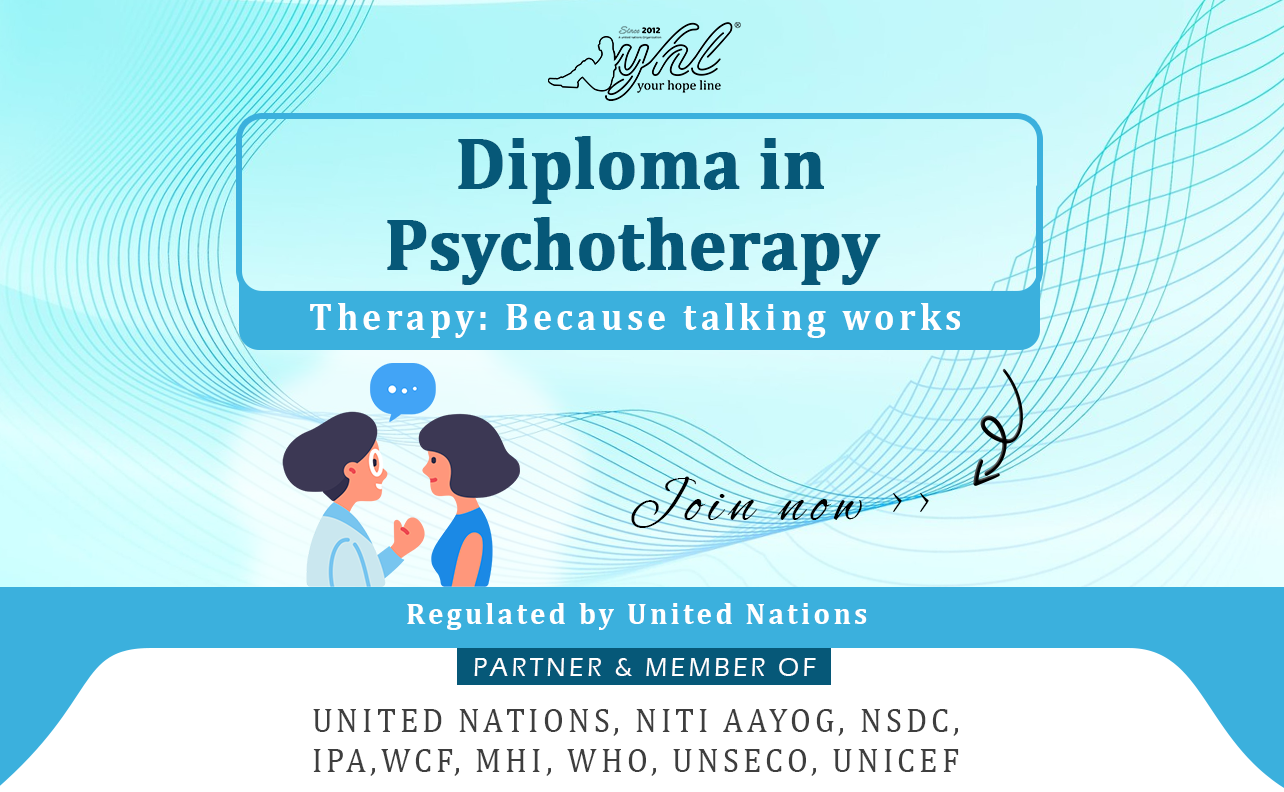
Diploma in Psychotherapy – Your Hope Line
United Nations Recognized | Niti Aayog Recognized | ISO 29993:2017

United Nations Recognized

Niti Ayog Recognized

ISO
29993:2017
29993:2017

Registration Card – Available

Duration – Fexible

Printed Notes – Available

Certificate on Merit – not available

Community Access – Lifetime

Payment Mode – One time
- Duration : 6 months
- Mode : Self-Placed
- Price : ₹15,000
₹20,000 - CoM : not available
Psychotherapy
- 1. What are counselling and psychotherapy?
- 2. What do people come to counselling and psychotherapy for?
- 3. What are the training routes in counselling and psychotherapy?
- 4. Where do counsellors and psychotherapists work?
- 5. The Basics of Therapeutic Practice
- 6. The Counselor as a Therapeutic Person
- 7. The Counselor’s Values and the Therapeutic Process
- 8. Issues Faced by Beginning Therapists
- 9. Resistance variables
- 10. Introducing therapeutic skills and clinical practice: the ‘basics’ of therapeutic practice?
- 11. The client-therapist relationship
- 12. Assessment
- 13. Risk: assessment, exploration and mitigation
- 14. Formulation
- 15. Using outcome and process measures
- 16. Therapeutic beginnings
- 17. Therapeutic middles
- 18. Therapeutic endings
- 19. Introducing professional issues: therapeutic skills ‘beyond therapy’
- 20. Personal and Professional development
- 21. Clinical supervision
- 22. Leadership
- 23. Confidentiality, note taking and record keeping
- 24. Ethical codes and guidance
- 25. Responding to complaints
- 26. Client experiences
- 27. Therapy and the law
- 28. Mental health law
- 29. Fundamentals of research
- 30. Psychoanalytic therapy, techniques and application to a case
- 31. Existential therapy, techniques and application to a case
- 32. Person centered therapy, techniques and application to a case
- 33. Gestalt therapy, techniques and application to a case
- 34. Behavior therapy, techniques and application to a case
- 35. Cognitive Behaviour therapy, techniques and application to a case
- 36. Family systems therapy, techniques and application to a case
- 37. Relaxation exercises and meditation
- 38. Biofeedback
- 39. Confrontation
- 40. Hypnosis
- 41. Play therapy
- 42. Art therapy
Hypnotherapy
- 1. Development of the Mind
- 2. Theory of the Mind
- 3. History of Hypnosis
- 4. Definition of Hypnosis
- 5. Creation of the Hypnotic State
- 6. Theory of Suggestibility
- 7. Discovering ones own Suggestibility
- 8. Pre-induction Interview
- 9. Clearing the Misconceptions and Fears around Hypnosis
- 10. Induction Scripts
- 11. Wordings of Suggestions
- 12. Breaking down the parts of a script
- 13. Laws of Suggestibility
- 14. Self-Hypnosis (Demo)
- 15. Signs of Hypnosis
- 16. Hypnotic Modalities
- 17. Dream Therapy
- 18. Deepening Technique - Script
- 19. Aura Scan
- 20. Universal Affirmation
- 21. Creating a Personal Affirmation
- 22. Journey of the Soul
- 23. Diagnostic Tools
- 24. Hypnodrama
- 25. Regression - Age / Past Life
- 26. Fears and Phobias
- 27. Desensitisation
- 28. Anxiety
- 29. Stages of Loss
- 30. Clinical Hypnotherapy
- 31. First Consultation
- 32. Family Systems & Defense Mechanisms
- 33. Case History Format
- 34. Physical & Emotional Sexuality
- 35. Discovering your Sexuality
- 36. Basic Theories of Psychology - Psychoanalysis, Behaviorism, Humanism
- 37. Adult Children of Dysfunctional Families
- 38. Your Body A Shadow of Your Mind
- 39. Preparation for Demo - First Consult
- 40. Demo - A Complete Hypnotherapy Session
Art Therapy
- 1. Art Therapy- History, Approaches
- 2. Art Journaling
- 3. Art & Psychology
- 4. Art Therapy & Personality
- 5. Mandala Art
- 6. Human Brain and Art
- 7. Disorder Management
- 8. Art Therapist & Workplace
- 9. Steps Taken by Art Therapist